|
|
|
|
M4A3E8 Sherman “Easy Eight”
Ryefield Model, 1/35 scale
Reviewed by Al Bowie
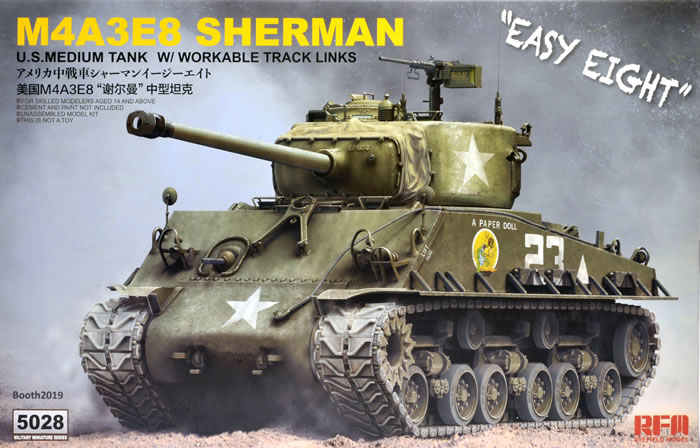
Summary
| Stock Number and Description | Ryefield Model Kit No. RM-5028 - M4A3E8 Sherman “Easy Eight” |
| Scale: | 1/35 |
| Media and Contents: | 10 Sprues (four of which are individual tracklinks – 1016 parts including four track assembly jigs) in tan plastic; 1 PE fret and a decal sheet with markings for two vehicles. |
| Price: | TBA |
| Review Type: | Superb level of detail and accuracy. |
| Advantages: | Excellent detail; high quality moulding; includes standard and balloon tyres. |
| Disadvantages: | Minor niggles such as constructing Individual tracks, loader's hatch springs. |
| Recommendation: | Probably the best 1:35 scale Sherman kit to dater but not without little (and I do mean little) problems like the loader’s hatch springs, markings etc. |
F i r s t L o o k
When I first started into large-scale armour kits in the early 1970s, I was in awe of a kit based on the artwork on the box. This kit was Tamiya’s M4A3E8 with tiger face markings from (unknown to me) the Korean War. Sadly this kit never lived up to the amazing artwork and is better confined to history.
This started a long time love of that Allied workhorse, the M4 Sherman.
Surprisingly for the Allies main tank, it took until the mid 1990s before we started to see a range of Sherman kits of any quality in 1:35 scale and since then it seems every new Sherman release is bemoaned by many as “not another Sherman kit!”, usually in disparaging terms.
The quality of the kits has steadily increased and occasionally takes a quantum leap as we saw when the Tasca Sherman’s hit the market with flawless fit, superior accuracy and a range of types previously unkitted.
This new kit from Rye Field Model is such a kit. It leaps ahead of what was the gold standard to many in Sherman kits and sets the bar a little higher.
RFM’s first Sherman kit was a complete surprise and is of the last of the Production Sherman’s – the M4A3 76mm HVSS commonly but erroneously referred to as the M4A3E8 and known to many as an “Easy Eight”. This has been kitted by many including Tamiya, Academy, DML, TASCA/ASUKA but this one is just that little bit better than its predecessors (which if you have built a current ASUKA/TASCA one or the New Tamiya one) gives an idea of its quality). It represents a late production WWII variant and the kit unsurprisingly has markings for two late war US examples.
The box contains ten main sprues of tan coloured styrene which four are the individual track links. An additional sprue of clear parts is included to provide periscopes and vison slots for the commander’s cupola. A small photo-etched fret rounds out the sprues. Instructions are typical for an RFM kit in a good A4 sized portrait format booklet in colour with clear black and white exploded view diagrams that I could actually read without my glasses - a bonus to many modellers I am sure. First examination reveals the quality of the moulding which includes almost all of the foundry casting marks on including such small parts as the hull glacis lifting rings. Hatches have detail inside and out with handles, casting numbers etc and can be displayed open or closed.
Construction starts with the turret, which is presented as an upper and lower shell and I have to say that despite the uber level of detail presents little problem other than getting some of the finer parts of the sprue.
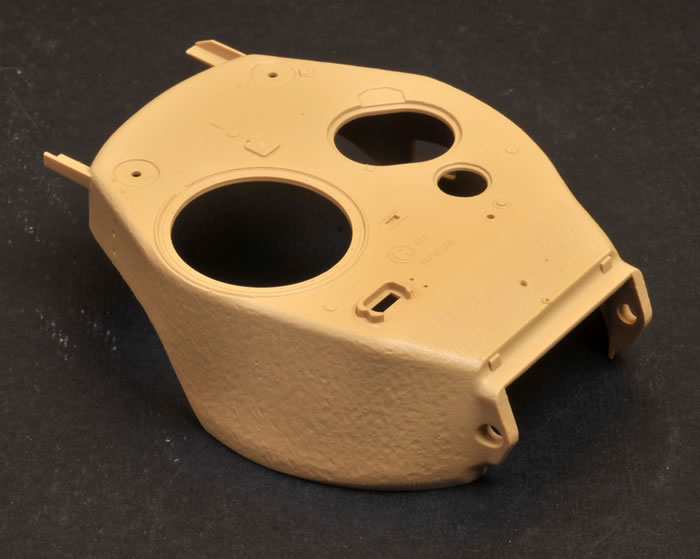
Periscopes may be installed raised or lowered and here is where I found the only real niggle in the kit. The springs are depicted on the loader’s hatch not being attached to the turret top in any way. They are just sitting unattached at the rear. This is a weird oversight on a kit with the level of detail present.
A note here regarding the periscope guards which are styrene – they are excellent.
Options such as antenna bases are called out in coloured window leaving you in no doubt. A multipart mantlet cover is included which has the mounting studs moulded to the cover. Two mantlets are provided including one to use with the cover which has the corner tubular mount to hold the mantlet but not the studs on either the turret or mantlet as they are moulded to the cover. This makes the option of no cover a bit more difficult. The optional mantlet is provided although this is not called out in the instruction despite later in the instructions showing it as an option when fitting the turret to the hull with separate instructions provided although they use the same parts – peculiar.
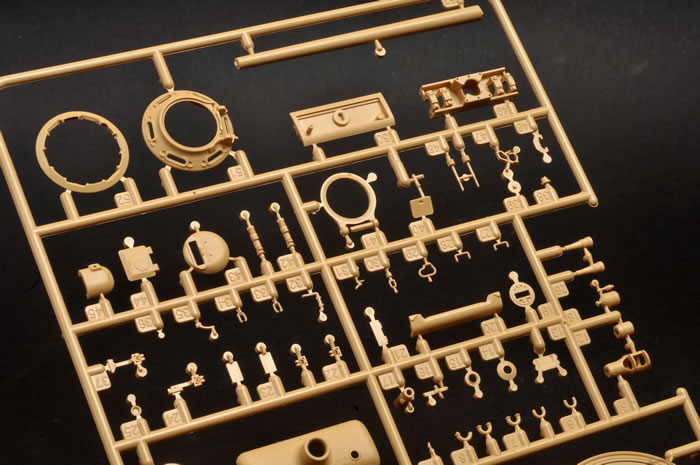
The turret mounted .50 cal is very well done in multiple parts although I ask why they have split the body as with the feed cover open it doesn’t really depict the bolt upper. The barrel extension jacket is well done in one piece and barrels with and without a folding change handle are included The muzzles are drilled out and with a good magnifier reveal rifling! The ammo can is moulded integrally with the tray and has optional lids either closed or with rounds feeding the gun. Separate charging handle and triggers are included making this a very nice .50 cal although I personally feel the TASCA ones just eclipses it in sharpness and detail.
The Commander’s cupola has separate clear styrene vision slots and is superbly detailed right down to multi-part hold open latch etc. Cast marks are included on the hatch interior and the hatch can be made to open. Other options include a folded down pintle for the 50 cal.
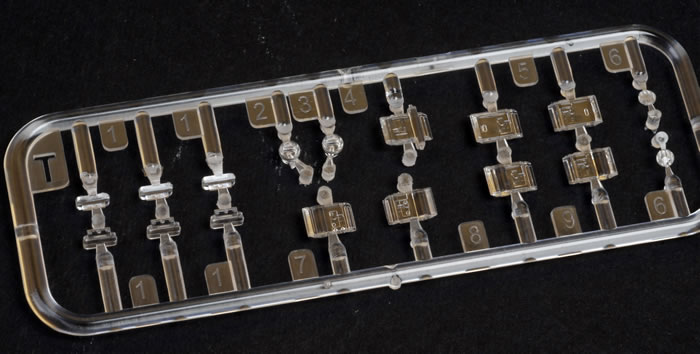
The next step takes us onto the hull and has you drill two tiny (.8mm) holes in the hull glacis from underneath. Don’t forget as they are only marked underneath – you have been warned). More details on the inner hull are a glacis inner (a hint of later interior set perhaps?), periscopes and detailed hatch locks including photo-etched latch handles. The driver’s hatches have seven parts each including rotatable periscopes and guards and internal and external handles. They are not workable but can be fitted open or closed.
Internal sponsons are then fitted along with the fenders in plastic. Glacis fittings are then added along with the hull machine gun, which is a one piece affair on ball mount.
No clear parts are included for the headlamps which have blackout shades fitted. RFM has depicted the hull ventilator well and include photo-etched mesh as well as a styrene cover. A securing ring is included for the hull machine gun cover as a separate part and photo-etched light guards are then fitted. It is worth noting the hull periscopes can be depicted closed or open. Photo-etched guards are one piece each but the horn guard is a multi- part affair.
The engine decks are reasonably well moulded but the handles sit proud. These in real life dropped down so maybe drill the holes out and let them sit lower if you want that level of realism/detail. They are detailed on the inside to a point as they do not have the large fairings normally seen attached.
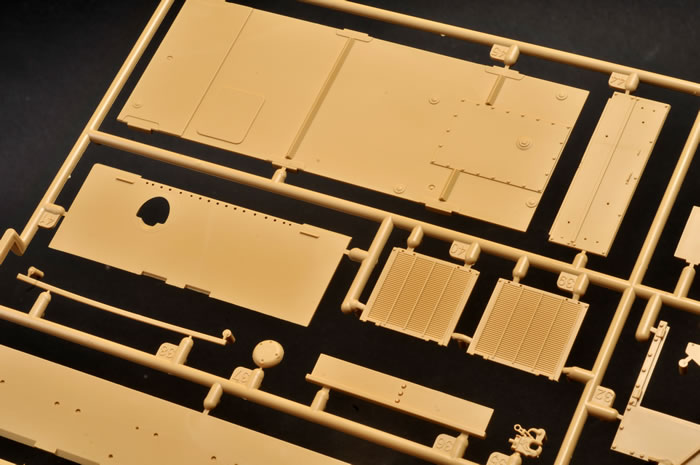
Stowed tools supplied are on par with the other manufacturers with moulded on mounts and straps on some etc. Definitely room for aftermarket straps etc. The rear stowage shelf can be depicted open or closed and four jerry cans are included as stowage. These are nicely done but not as finessed as the Tasca ones. The rear plate with towing pintle is well done and even has a fine PE clasp latch in three parts which secures the tow pintle from swivelling when not in use.
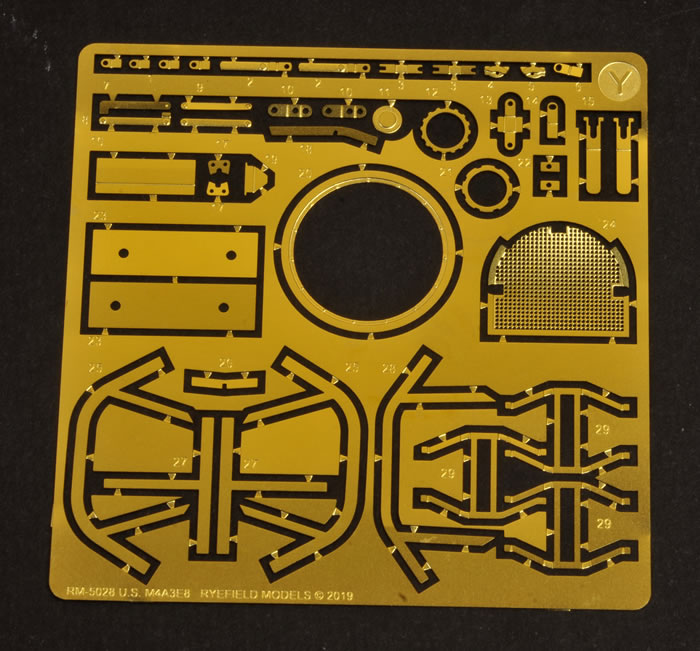
The lower hull is a multi-part affair and fits well, just like Tasca. The rear idler mounts are correct and not L-R handed like the Tamiya ones. They are well detailed with adjustment heads etc. The final drive assembly and transmission housing are really well done and detailed. Like Tasca, RFM recognise these are bolted to the hull and they fit! Three differing types of drive sprockets are supplied and all well detailed – exercise care in removing from sprues. The same goes for all the small parts. The bogies are multi part and follow the instructions carefully and they articulate almost like the real thing. They are not hard to assemble.
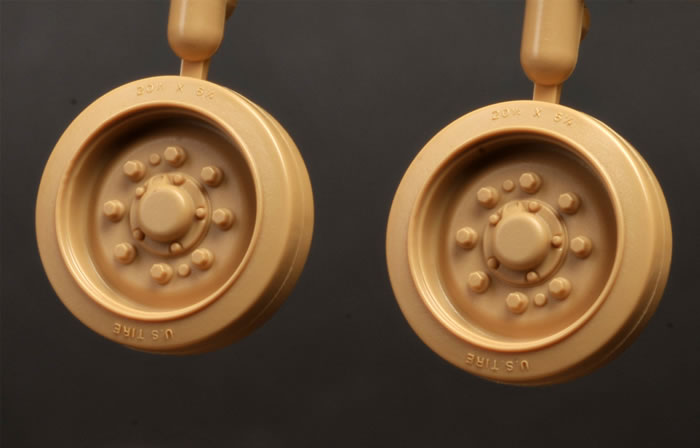
This brings us to the fiddliest part although as individual tracks go these aren’t too bad. The T80 double pin track is supplied as 76 links per side. Each has four pad halves and one piece track pin assemblies.
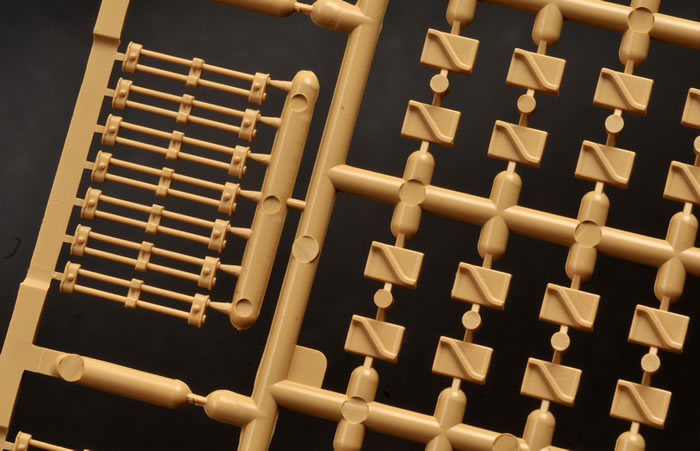
A supplied jig (4 included) makes assembly easier and alignment guaranteed.
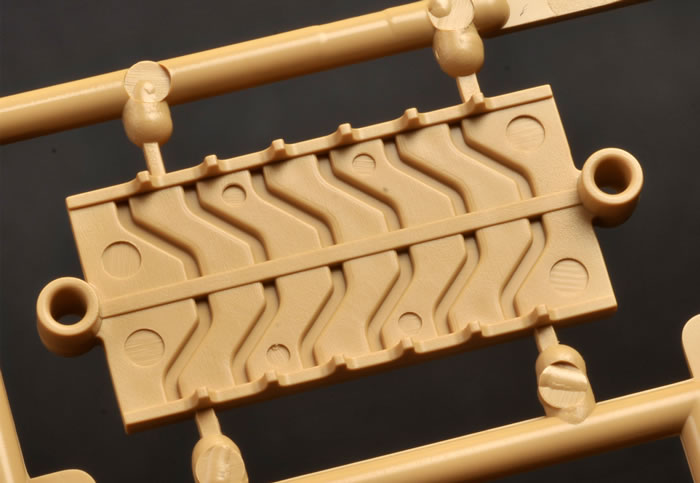
The pins come in section of seven and following the instructions here really helps leave one end on the sprue and they are an almost drop fit with seven at a time. Individual hollow guide teeth are then added then the inner pad faces. These will be time consuming but not as bad as I had originally thought. If you are careful they articulate.
Final details are then added in the form of the tow rope with detailed latch assemblies to hold it in place, and the exhaust deflectors correct for a late WWII M4A3. These may be positioned in use or in maintenance mode (lifted and locked). The multi-part gun is assembles with five parts making up the muzzle brake, which attaches to a one piece tube. Not mentioned in the instructions is a threaded end cap for an M1A1 tube which is superbly detailed again indicating further variants. The turret then is placed onto the hull via its spacer ring.
Additional parts are included in the form of .30 cal on pintle, spare ammo boxes for .50 and .30 cal, a folded .50 cal tripod and open .30 cal one. Three M3 Thompson sub machine guns are supplied as well.
Decals are included for two examples. The first is a black over Olive Drab example of 12 AD Germany 1945 with no markings other than white stars. The second is “Paper Doll” Number 23 of 68th Tank Bn Germany 45 which has hull art in the form of a boxing turtle.
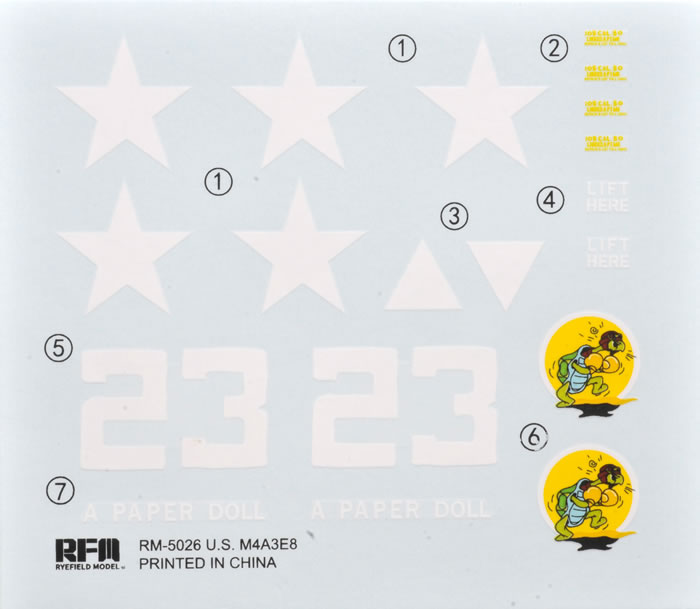
Again no stencils, Divisional or Registration markings are present only white stars, hull number, a white triangle and name plus art. A colour guide is included on an A 4 Sheet with Side, front and rear views but no overhead view. My references indicate “Paper Doll had T66 Single pin tracks however. No stars are provided for turret roofs. Paint callouts are all AMMO by MIG.
C o n c l u s i o n
So after a lengthy examination, I ask myself is this the perfect Sherman model at last? It is probably the best so far but not without little (and I mean little) problems like the loader’s hatch springs, markings etc.
The kit makeup indicates further variants down the track and who knows, maybe the first mainstream M4 kit with interior.
I really like this kit but it is not for the beginner although an intermediate modeller should be fine with patience.
I welcome this new addition to the market and hope for many more variants of Sherman’s to come from RFM going by their track record so far. I would hope they add the option of rubber band tracks and plastic alternative to the PE in later kits for the average/beginner modellers.
Also please look at your marking options RFM, Tanks have registration numbers and Unit markings etc. I still can’t do the Tiger faced one as that has the later post-war modifications but this can be made into a number of excellent late war subjects
Thanks to Ryefield Model for the sample www.ryefield-model.com
Text by Al Bowie
Images by Brett Green
Page Created 1 July, 2019
Page Last Updated
1 July, 2019















